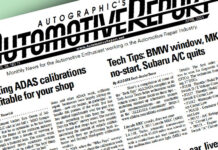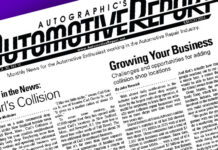From estimate line items to materials invoicing and shop backlogs, here’s what’s happening
By John Yoswick
Making decisions about your business can be tough, with so many factors playing into what the best move may be. Here’s a look at some stats and trends both within the industry and elsewhere in the economy that could influence your business.
More parts, higher prices, lower margins
A presentation at this spring’s Collision Industry Conference (CIC) may help explain why shops that are seeing their average repair order rise may still see margins declining.
Susanna Gotsch, director of industry analysis for CCC Information Services, said that parts as a percentage of overall repair costs have continued to climb. In 2003, for example, parts accounted for 42 percent of the overall repair costs for 2003 vehicles.
“By 2016 and 2017, that number [for 2016 and 2017 vehicles] had grown to nearly 47 percent,” Gotsch said. “So unfortunately, the area of the repair bill that potentially has smaller margins than labor…continues to grow.”
That’s based in part on the increased complexity of vehicles. Gotsch cited the Honda Accord as an example.
“In 1996, the front bumper had about 15 individual parts,” she said. “By 2015, that part had 23 or 24 individual components, depending on the configuration of that vehicle.”
Those additional parts also are not low-cost rivets or bolts, she pointed out, but rather more cameras, sensors and wiring harnesses.
Average labor hours per claim
The total number of labor hours per claim hit its most recent peak in 2007 at 23.5 hours, according to CCC data. It then dropped along with the economy, bottoming out at 22.3 hours in 2010. About 2013 it began a slow rise, hitting 23.1 hours last year, close to pre-recession levels.
CCC on labor rates
CCC data also indicates that the national average paint or body labor rate rose last year by $1 (an increase of about 2 percent) to just under $49. Body labor rates have risen an average of only about 1.4 percent per year over the last four years.
Frame and mechanical rates have risen a bit more over the four years (1.6 percent and 2.1 percent, respectively). Last year’s national average frame rate was $56.52 and the national average mechanical rate was $84.83. The national average rate for paint materials has grown an average of 2 percent per year over the last four years, including a 2.7 percent increase in 2017 to $29.09.
It’s important to remember that CCC’s reported data generally includes direct repair claims only.
Scanning as an estimate line item
CCC says that based solely on automaker position statements, 70 percent of all vehicle damage appraisals in 2017 should have included a pre- or post-repair scan. Despite this, only 9 percent of CCC estimates during the year included a scan (at a charge averaging $90, either as a flat-fee or based on labor time).
CCC said this compares to 4 percent of 2016 estimates including a line-item for a scan (at a fee averaging $149).
It’s important to keep in mind, as CCC noted, “The absence of a scan entry in the appraisal does not necessarily mean that the scan was not performed.”
Average age of vehicles
Although an older vehicle population in a state may be a boon for the mechanical repair industry, those are the vehicles most likely to be declared a total loss when they arrive in a body shop. An AudaExplore study found that vehicles 10 years old or newer account for more than 85 percent of collision-damaged vehicles that are repaired rather than totaled, and CCC reports that the average age of vehicles being repaired in 2017 held steady at 5.9 years, having fallen from a peak of 6.2 years in 2013.
IHS Automotive reports that the average vehicle age in the United States is about 11.6 years of age. But on a state-by-state basis, that average ranges from a low of 9.6 years in Massachusetts to a high of 15.4 years in Montana. Other states with an older vehicle population include Alabama (13.6 years), Mississippi (13.3 years), South Carolina and Kentucky (12.7 years).
Along with Massachusetts, the states with vehicle populations averaging under 10 years or younger are Texas, Vermont, Oklahoma and New Hampshire.
Percentage of insured drivers
A consumer is more likely to get a vehicle repaired after an accident if that vehicle — or the driver responsible for the damage — is insured. So higher rates of uninsured drivers in a state could make doing business in that state somewhat less attractive for collision repairers.
The Insurance Research Council estimates that about one-in-eight drivers on the roads in the United States is uninsured. But again, the rates vary widely by state. Only 4.5 percent of Maine drivers are uninsured, according to the Council’s report, compared to a whopping 26.7 percent in Florida.
Among the states with uninsured driver rates topping 15 percent are Mississippi (23.7 percent), Tennessee (20 percent), Alabama (18.4 percent), and Arkansas (16.6 percent).
The states with uninsured rates below 9 percent include Wyoming (7.8 percent), South Dakota (7.7 percent), Kansas (7.2 percent) and Nebraska (6.8 percent) and North Carolina (6.5 percent).
Number of registered vehicles
The more vehicles there are in a state — particularly in denser, urban locations where those vehicles are more likely to “meet up” with one another — the better that state likely is for collision repairers. But ranking states purely on vehicle count doesn’t take into account the wide variations in state populations as well.
It may be more useful to compare the registered vehicle count in each state to the number of collision repair employees in each state. How many people are working in the industry is one indication of that state’s “repair capacity.” A state with lots of repair capacity — many people trying to earn a living through collision repair — but low vehicle count could indicate the state has a glut of repairers. Conversely, states with a higher number of vehicles for each collision repair employee are those in which shops may well be doing better.
Using data on from the U.S. Census Bureau, Alabama would appear to be the state in which shops may most be benefitting from this ratio. There are 1,823 registered vehicles for every collision repair employee in Alabama. At the other end of the spectrum, there are only 583 registered vehicles for every collision repair employee in Rhode Island.
Other states with seemingly a lot of competition for collision repair work (based on employee-to-vehicle ratios) include Illinois, California and Missouri, all of which have under 1,000 registered vehicles per collision repair employee.
Using this measurement, shops may be faring better in Kentucky, Florida, Idaho, Arkansas and Wyoming, which are among the states (along with Alabama) with more than 1,639 registered vehicles per collision repair employee.
Winners and losers among insurance companies
Data from the National Association of Insurance Commissioners (NAIC) show that Allstate Insurance in 2017 once again lost market share to Geico and Progressive, officially falling to fourth place among the largest personal auto insurers in the United States in terms of direct premiums written.
Allstate dropped from its long-held No. 2 spot back in 2013 when Geico surpassed Allstate. Now Progressive has overtaken Allstate to become the third-largest personal auto insurer in the country.
Allstate, which has been ceding an average of 0.19 percent of market share to its competitors every year for the past 10 years, lost another 0.43 percent in 2017.
The only other change in ranking among the Top 10 in 2017 was Travelers, which climbed above American Family to take the No. 9 spot.
Geico once again in 2017 grew market share faster than any of the other 10 largest insurers. The company’s personal auto business has outpaced all others over the past decade, averaging more than half a point of market share growth every year since 2007.
Combined, the Top 10 insurers collected 72.3 percent of the $230.6 billion in annual personal auto insurance premiums paid in 2017, according to the NAIC numbers. That is up from 65.6 percent a decade ago.
State Farm remains the largest personal auto insurer by a large margin, with 18.1 percent market share. That is 5.3 percentage points more than No. 2 Geico. Even if Geico’s growth rate over the past decade continues, it will take nearly 10 years for Geico to challenge State Farm for the top spot.
There also were winners and losers in 2017 among some of the insurers just outside the Top 10. Hartford struggled in 2017, dropping from the No. 14 spot to No. 18. Conversely, Auto-Owners saw a nearly 19 percent increase in total premiums, helping the company jump from No. 18 to No. 16, passing both MetLife and Hartford.
Consumers continue to spend more on auto insurance
The latest figures released by the National Association of Insurance Commissioners show that consumer spending on personal auto insurance rose 2.7 percent to $889 in 2015, slightly slower growth than the previous two years (each at 3.2 percent) but still the third-highest growth rate in the prior 10 years. The increase was more than four times the rate of inflation for that year, and was the sixth consecutive year of growth (after five prior consecutive years of decline).
It’s important to note that the 2.7 percent increase was the rise in average expenditure, not average premium. That means some of the increase could be caused by consumers buying more coverage than they did previously, as would likely be the case in a year with strong growth in new-car sales (buyers are often required by their lending institution to carry collision coverage).
Comparing average expenditures by state can be misleading because some states mandate that drivers carry more coverage than others. But the highest average expenditures in 2015 were in New Jersey ($1,266), New York ($1,235), Louisiana ($1,232), Michigan ($1,231) and the District of Columbia ($1,190).
The lowest average expenditures were in North Dakota ($638), Maine ($618), South Dakota ($616), Iowa ($599) and Idaho ($574).
Looking over a 10-year period, the states with more than a 10 percent increase over that time include Mississippi (10.9 percent), Florida (11.4 percent), Tennessee (11.9 percent), South Carolina (13.2 percent), Georgia (14.2 percent) and Louisiana (14.3 percent).
Materials invoicing systems seeing increased use
Although the majority of shops are still using a simple calculation of dollars-per-refinish-hour to bill for refinish materials on estimates, a “Who Pays for What?” survey (www.CrashNetwork.com/collisionadvice) earlier this year found that the percentage of shops using materials invoicing systems to calculate these charges has increased.
Of the 708 shops that responded to the question, 23 percent of are using some kind of invoicing system to calculate their materials charges; that is up from the previous two years when about 19 percent of shops said they were using an invoicing system.
The survey, conducted in January by Collision Advice and CRASH Network, also showed that among those shops using invoicing systems, well over 50 percent of them are being paid based on those invoices “always” or “most of the time” by seven of the eight major insurers in the survey.
Shop backlogs
The “Who Pays for What? survey in January also found the typical backlog of scheduled work in shops across the country increased by three days compared to the fourth quarter of 2017. Shops across the country on average in January were scheduling two weeks into the future, up from 1.7 weeks at the beginning of the fourth quarter of last year.
Of the nearly 700 shops across the country that responded to the question, 36.7 percent said they were scheduling work two or more weeks into the future; that was up from 29.3 percent in October.
The majority of shops (63.3 percent) said they were scheduling repairs less than two weeks out, but that is less than the 70.7 percent who had less than a two-week backlog last October. At the same time, 8.7 percent of facilities nationally said they are scheduling out four weeks or more.
Backlogs increased in nearly every part of the country, with only the Southeast region of the United States reporting no change (still averaging 1.6 weeks of backlog). •
John Yoswick, a freelance writer based in Portland, Ore., who has been writing about the automotive industry since 1988, is also the editor of the weekly CRASH Network bulletin (www.CrashNetwork.com). He can be contacted by email at john@CrashNetwork.com.



